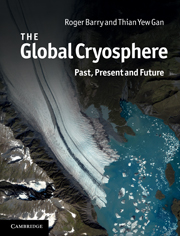Book contents
- Frontmatter
- Contents
- Preface
- Acknowledgements
- 1 Introduction
- Part I The terrestrial cryosphere
- 2A Snowfall and snow cover
- 2B Avalanches
- 3 Glaciers and ice caps
- 4 Ice sheets
- 5 Frozen ground and permafrost
- 6 Freshwater ice
- Part II The marine cryosphere
- Part III The cryosphere past and future
- Part IV Applications
- Glossary
- References
- Index
- Plate section
5 - Frozen ground and permafrost
from Part I - The terrestrial cryosphere
Published online by Cambridge University Press: 05 June 2012
- Frontmatter
- Contents
- Preface
- Acknowledgements
- 1 Introduction
- Part I The terrestrial cryosphere
- 2A Snowfall and snow cover
- 2B Avalanches
- 3 Glaciers and ice caps
- 4 Ice sheets
- 5 Frozen ground and permafrost
- 6 Freshwater ice
- Part II The marine cryosphere
- Part III The cryosphere past and future
- Part IV Applications
- Glossary
- References
- Index
- Plate section
Summary
History
Martin Frobisher first reported the existence of frozen ground in Baffin Island in 1577 according to Muller (2008). Tsytovich (1966) noted that Russian military reports published in 1642 contain the first mention of frozen ground in Siberia. James Isham reported the presence of frozen ground near Hudson’s Bay in 1749 (Legget, 1966). Karl von Baer stated that the earliest scientific report of the existence of frozen ground was made in a work on the flora of Siberia published as an outcome of the Russian Great Northern Expedition by J. G. Gmelin in 1751 in Göttingen, but skepticism existed in scientific circles into the nineteenth century. The first widespread recognition of the occurrence of frozen ground appears in papers presented to the Royal Geographical Society of London by von Baer (1838a,b). He reported on the presence of frozen ground in Siberia and noted that a merchant named Fedor Shergin sank a well at Yakutsk between 1828 and 1837 and collected temperature measurements from it for Friederich Wrangel. He found that the temperature rose steadily to near 0 °C at 116 m depth from –7.5 °C at a few meters below the surface. von Baer (1838b) noted other locations in Siberia where the ground was permanently frozen. A book prepared by him in 1842, but never published, has recently been made available in German by Tammiksaar (2001). Baer’s text shows that he had already prepared a map of the distribution of permafrost in Siberia whose boundary closely resembles that of later authors. Baer also directed the expeditions of A. T. Middendorff to eastern Siberia, including temperature measurements to 116 m depth in the Shergin well at Yakutsk (Middendorff, 1844) and in other boreholes at locations east of the Yenisei River to the Pacific Ocean. Middendorff’s data show that the permafrost thickness at Yakutsk was 190 m, according to Shiklomanov (2005).
- Type
- Chapter
- Information
- The Global CryospherePast, Present and Future, pp. 165 - 189Publisher: Cambridge University PressPrint publication year: 2011

